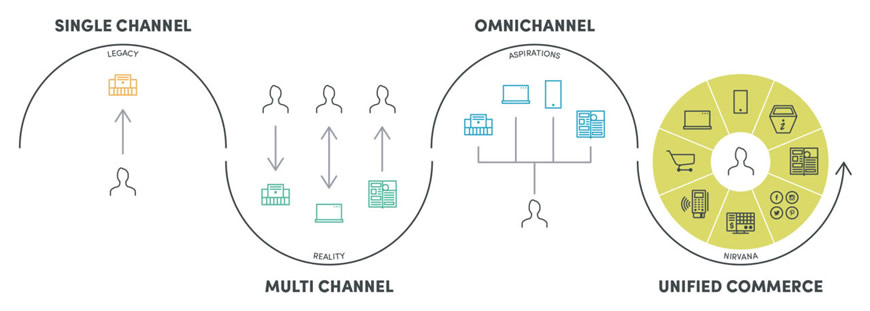X-Commerce: SYS-DAT's Unified Ecommerce platform
Integration of all sales channels as a differential business ingredient.
The last 10 years have shown a radical transformation of the main Go To Market models adopted by companies, shaping up as an irreversible evolution that has affected almost all commodity sectors.
It was not just an acceleration related to “the introduction of digital,” in the broadest sense of the term thanks to or cause of the pandemic, but rather and far more, a new, different and now established way of interacting, communicating and obviously buying that, both individuals and companies, have adopted.
Simplifying as much as possible, it can be said that the sales channels have been conforming to new compelling needs dictated by the market, complementing each other and, in some cases, almost merging. On the one hand, there has been a need on the part of consumers to search for and purchase goods and services in a new “static mobility,” thus through a wide variety of “mobile devices” albeit in static contexts such as their own homes, and, on the other hand, that of companies that have been able and required to search for and find new sales approaches to meet the needs of their customers.
In a nutshell just as individuals have abruptly become accustomed to socializing and buying in a new “semi-virtual” or “semi-physical” mode, at the same time and as a result companies have had to rethink their contacts, including sales, with their customers.
In this scenario, only those companies that were able and able to adapt to this new model gained a concrete competitive advantage.
What and how did they do it? They were able to adopt a Unified Commerce model.
What is meant by this term? An extremely simple and articulate concept at the same time. We refer to being able to adopt a single, integrated and unified sales approach to the Customer. Just as the Customer must be able to interact with the company that offers him or her a service or product by receiving the same “buying experience,” regardless of how he or she comes into contact with the company, the company itself must be able to access customers by benefiting from the integration and, above all, consistency of all direct and indirect, physical and virtual B2B and B2C sales channels.
In this way, the Customer, who is increasingly at the center, must be able to search for the product independently of intermediaries and sales channels and, at the same time, the company must be able to govern, monitor and manage with the same approach all of its sales network in order to satisfy the consumer’s purchasing need. The focus should be on what is called the Customer Journey.

A Unified Commerce approach can be considered as the evolution of models based on mono/multi-channel and omni-channel.
The channels through which a company relates to its Customers can no longer be managed with separate approaches and tools and, consequently, sales systems such as:
- B2B solutions (online sales through resellers);
- Physical showrooms (mainly B2B sales in dedicated spaces);
- Virtual Showroom (predominantly B2B virtual sales);
- B2C solutions (online sales to the end customer);
- Market Place (multi online store);
- Solutions to manage Corners or Shop in Shops in large-scale retail trade or Department Stores (specific spaces in shared environments)
- Single-brand or multi-brand, static, temporary or itinerant retail solutions (through physical sales through stores);
- Phygital models (B2C online sales with Seller-Customer interaction);
- X2X Solutions (two-way sales between marketplaces and retailers)
they must evolve, integrating, from a purely IT point of view, “merging” into a single approach, making the same purchasing experience appear to the Customer. Companies today operate in an ecosystem that is both physical and virtual, oriented towards B2B and B2C channels, also integrated bi-directionally with offline and online Martekplaces. This “fusion context” represents a prerequisite from which we must start by placing the Customer, with his purchasing experience, at the center.
Contact us

SYS-DAT’s many years of experience in enterprise solutions, and in particular in managing solutions for sales networks, has enabled the creation of a Unified Commerce platform, X-Commerce, capable of integrating and merging all channels and, consequently, sales tools.
The X-Commerce SYS-DAT solution integrates the following own solutions into a single platform allowing the company to be able to enable individual modules, and thus approaches, based on actual needs dictated by business evolution but always maintaining process integrity and absolute consistency:
- B2B Wholsale&Retail;
- Virtual Showroom;
- B2C;
- Retail in Store;
- HUB Market Place (integrator between company and major B2B and B2C marketplaces);
- B2B2C;
- CRM (B2B and B2B);
- Analytics&Forecasting.

The advantages of companies in adopting X-Commerce are as undisputed as they are, today, essential and differential elements. Uniformity and standardization product information, actual and future, physical and virtual inventories, integration of internal and external logistics, interoperability between different channels by being able to prepare flexible commercial policies, uniformity in information dissemination and centralized marketing actions are just some of the benefits!
The line is drawn and the evolution is clear: it will soon lead to “X2X models.” What is meant by X2X?
We are referring to the fact that anyone, as long as they are enabled, will be able to sell products and services of any type by drawing from a wide variety of physical and virtual platforms by espousing “infinite shelf” logic (I sell any product regardless of the actual stock knowing that at some of my Partners exists …). In this way, even smaller entities will be able to benefit from the same opportunities as the big ones by making simple business deals. The B2B2C platform is an example of this, and with X-Commerce this is all possible today!
In summary, with X-Commerce, new business models open up: companies can think about selling products that they do not physically have but offer by virtue of simple business arrangements.
Contact us
